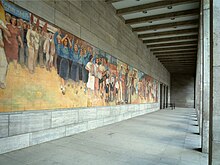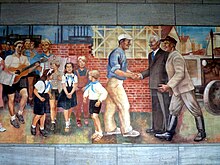



Max Lingner (17 November 1888 – 14 March 1959) was a German painter, graphic artist, communist, and resistance fighter against the Nazi regime.




Max Lingner (17 November 1888 – 14 March 1959) was a German painter, graphic artist, communist, and resistance fighter against the Nazi regime.
Born in Leipzig, the son of a xylographer, Lingner graduated from high school in 1907 and studied as a master student under Carl Bantzer at the Dresden Academy of Fine Arts, where he completed his training in 1912 with a painting Singing Girls, for which he received the "Saxon State Prize". On a study trip in 1913/1914 he visited England, the Netherlands, France and Belgium.
In First World War he had to fight on all fronts. In 1918, he took part in the Kiel mutiny and became a member of the soldiers' council in Kiel. He settled in the village of Born on the Darß from 1919 to 1922, but failed as a farmer. From 1922 to 1927, he worked as a painter and graphic artist in Weißenfels, but greater successes failed to materialise. On the advice of Käthe Kollwitz, he moved to Paris.
The first years in the French capital also passed without any great impressions for him. The tide turned when Henri Barbusse won him a job at the weekly newspaper Monde. Here Lingner's great talent as a press artist became apparent, so that he was soon entrusted with the entire artistic design of the newspaper. The Monde appeared from 1928 until Barbusse's death in 1935. From 1931 onwards, Lingner's style shaped the appearance of the newspaper. He created drawings for title pages, but also drawings and illustrations for the published texts and literary supplements.
With these works, he found his way into Parisian artistic life. In 1934, he joined the Association of Revolutionary Writers and Artists of France (AEAR). He participated in exhibitions of this group. In 1933, Lingner showed his first works at the Galerie Billet (Pierre Vorms[13]), and further exhibitions took place in Paris in 1939 and 1947.
The paintings and drawings shown there were created alongside his daily work as a press illustrator. He also brought back hundreds of ink drawings from his forays through Parisian working-class suburbs - the banlieue - and motifs and people from these wanderings were often found in his paintings and press drawings. He liked to paint and draw motifs of French women.
[17] proposed by the Max-Lingner-Stiftung in Berlin. The inauguration in the presence of representatives of the Max-Lingner-Stiftung took place on Saturday 14 March, just before the confinement. The museum reopened on 3 June and the exhibition has been extended until 26 July:((cite web|http://www.museehistoirevivante.fr/expositions/exposition-du-14-mars-au-26-juillet-2020/max-lingner-a-la-recherche-du-temps-present.</ref> A slide show presents the work of Max Lingner and the exhibition: https://www.youtube.com/watch?v=Z2zWLaIRoxA.Max Lingner. À la recherche du temps présent
In 1939, during the exhibition of works by Max Lingner, the art critic George Besson could write in Ce soir:[18] Max Lingner's sketches have for ten years been the ornament of the proletarian press (...) Lingner scattered more than 6,000 drawings of a very particular sensitivity and expressive line. An opportunity arises to discover another no less human aspect of Lingner's work, for he is the painter of serious Parisian landscapes (...) and compositions to the glory of a youth whose attitudes speak of joie de vivre and health.
After the closure of Monde he worked for the newspaper of the trade unions La Vie Ouvrière and for the newspaper of the youth l'Avant-Garde and the newspaper of the Parti communiste français l'Humanité, of which he had been a member since 1934. From 1939 to 1940, he was imprisoned and held in the Gurs internment camp in southern France. He was interned, escaped and lived illegally under the name Marcel Lantier. He joined the French Resistance Movement in 1943 and returned to Paris in 1944. Again, he worked for l'Humanité and, despite serious illness, devoted himself to painting.
In 1949, he returned to Germany and became professor of contemporary painting at the Weißensee Academy of Art Berlin. On his return, he donated 40 paintings, watercolours and drawings to the "People of Progressive Germany". Among them was one of his most famous paintings, Mademoiselle Yvonne. In 1950, he and others founded the Academy of Arts, Berlin. During this period he came under suspicion of "Formalism", being accused of his French-influenced visual language. Even one of his most outstanding works, the monumental Wandbilder aus Meißner Porzellan "Aufbau der Republik" from 1952 at the former House of Ministries (today the Federal Ministry of Finance, during the Nazi era Reich Air Ministry) in Leipziger Straße, came under criticism from government and cultural officials. Lingner was accused here not only of the lightness of the figures, which was typical of his "French" style, but also that he had not depicted a tractor in the painting accurately according to the actual model. The painting was eventually adapted to meet most of the points of criticism.

In addition to the mural, his work Two Wars - Two Widows is also one of Lingner's most important paintings. Lingner lived in Niederschönhausen in the house Beatrice-Zweig-Strasse 2. His grave is located in the municipal Pankow Cemetery III on Leonhard-Frank-Strasse in Niederschönhausen. It is dedicated as an Honorary Grave of the City of Berlin.
Lingner died in Berlin at the age of 70.
In 1969, the Max Lingner Archive was established in Lingner's former home and studio as a branch of the German Academy of Arts in Berlin (East), which remained in the possession of Lingner's widow until her death in 1997. The administration of the estate was then continued by the art historian Dr. Gertrud Heider, who also headed the Max Lingner Circle of Friends. Since March 1999, Lingner's written estate as well as photographs of his work, press graphics and a small part of his artistic oeuvre have been in the archive of the Academy of Art, Berlin. The materials are being scientifically processed there and are available for public use. After Gertrud Heider's death in August 2007, the Max Lingner Foundation was founded in her will, which is supervised by the Rosa Luxemburg Foundation but is free in its work. It supports the further processing of the part of the artistic estate remaining in the Lingner House. Among others, the former Berlin Senator for Culture Thomas Flierl is represented on the board.
